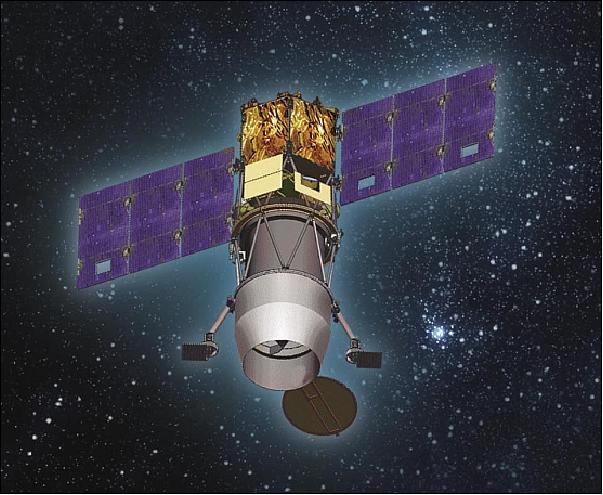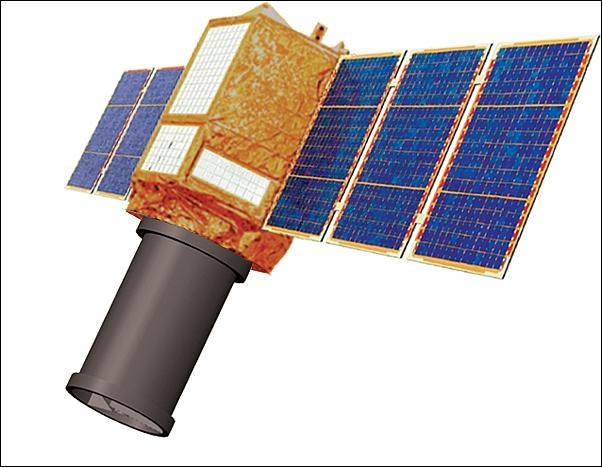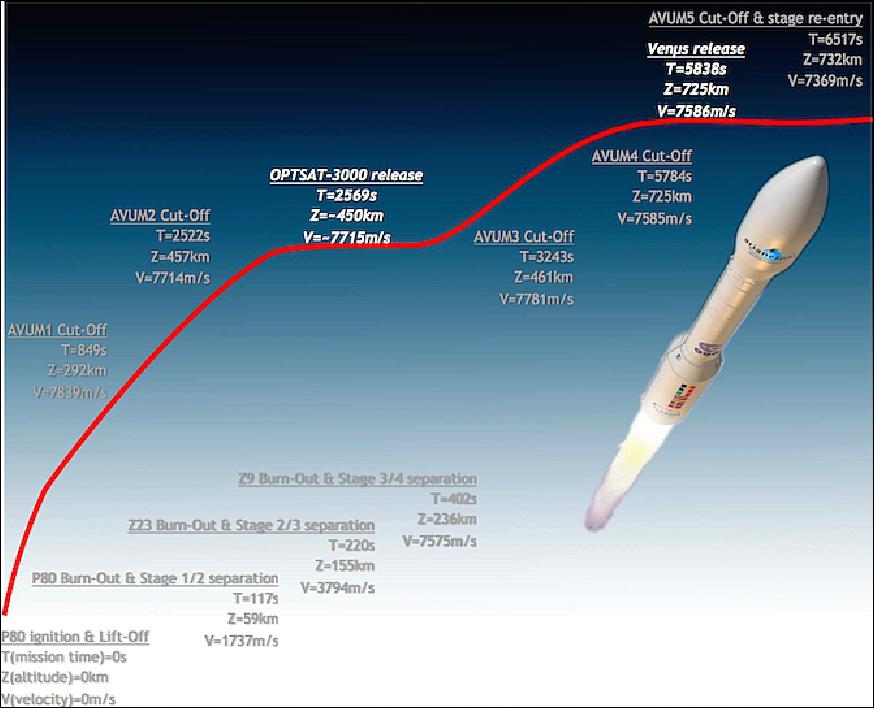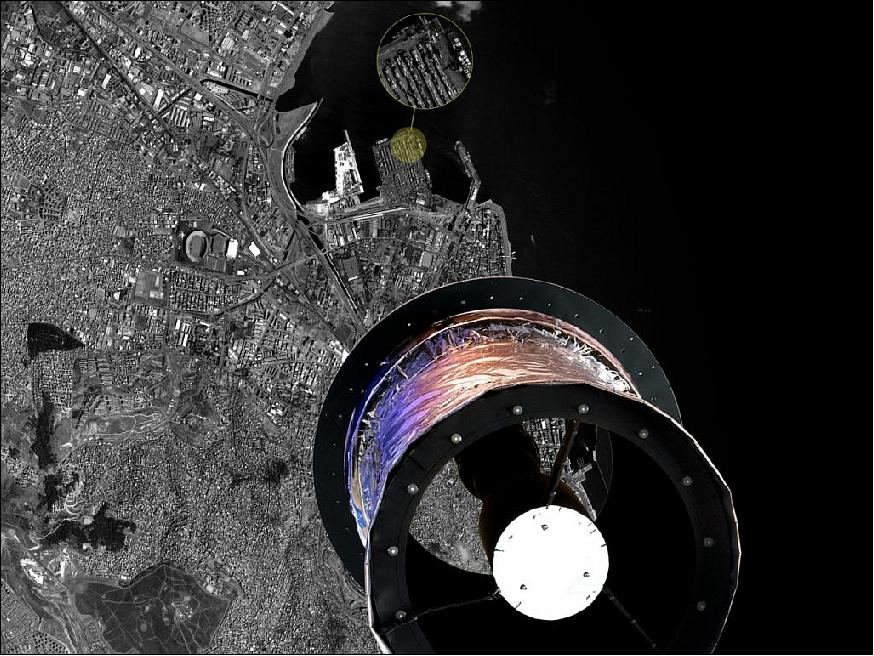OptSat-3000
EO
Operational (nominal)
MoD (Italy)
Quick facts
Overview
| Mission type | EO |
| Agency | MoD (Italy) |
| Mission status | Operational (nominal) |
| Launch date | 02 Aug 2017 |
| CEOS EO Handbook | See OptSat-3000 summary |
OptSat-3000 (Optical Satellite-3000)
Spacecraft Launch Sensor Complement References
OptSat-3000 is a third-generation high-resolution spacecraft built by IAI's (Israel Aerospace Industries) for the Italian Ministry of Defense, on behalf of the prime contractor team, CGS S.p.A. and Telespazio (Finmeccanica/Thales). The OptSat-3000 spacecraft is based on a new generic small platform which can accommodate various types of payloads. Telespazio will be responsible for the overall system including the ground control station. 1) 2)
OptSat-3000 technology represents a breakthrough in terms of weight to performance ratio, achieving high agility, very high quantities of widely spread images in each satellite pass, and high levels of autonomy.
Note: The Ofeq-9 spacecraft (launch June 22, 2010) is the first spacecraft using the OptSat-3000 platform.

Spacecraft
OptSat-3000 is a new generation of optical minisatellites of IAI/MBT (Israel Aircraft Industries Ltd.); they are based on MBT's IMPS-II (Improved Multi-Purpose Satellite-II) bus and are designed for a mission life of "more than 6 years."
The low launch mass of ~400 kg (of TecSAR heritage) and its compact size give the spacecraft a low inertia, providing in turn a high agility, which allows it to collect a large number of widely-spread imagery in one satellite pass. In particular, the bus has been designed for a higher pointing accuracy.

The OPTSAT-3000 system is supplied by the prime contractor Telespazio, a joint venture between Leonardo (67%) and Thales (33%). Telespazio is responsible for the entire system, including the satellite, ground segment, launch and early orbital operations, preparation and execution of operations and logistics, in-orbit tests and commissioning. 3)
The satellite and ground control systems were built by Israel Aerospace Industries (IAI), chosen by the Italian Ministry of Defense on the basis of an inter-governmental agreement between Italy and Israel. OHB Italia is responsible for the launch services and related engineering support.
The OPTSAT-3000 system will be inter-operable with Italy's second-generation COSMO-SkyMed radar satellites. This will give the Italian Defense Ministry access to state-of-the-art technology, and ensure maximum operational capabilities because of the combined optical and radar data offered by the two systems.
OPTSAT-3000 is a three-axis stabilized satellite, highly autonomous and combining reduced weight, low power consumption, and high reliability.
The satellite features:
• High resolution
• High-precision geolocation
• High-quality images
• Reduced weight, which allows a wide range of launch options
• High agility, thanks to the satellite's reduced weight and small size. This means low inertia, which in turn allows the acquisition of a large number of images
• Design life exceeding seven years.
The OPTSAT-300 has a mass of 368 kg and a size of 4.58 m x 3.35 m in deployed configuration. 4)


Launch
The OptSat-3000 and VENµS minisatellites were launched on August 2, 2017 (01:58 UTC) on the Vega vehicle (VV10) from the Guiana Space Center in Kourou. 6) 7) 8)
Arianespace and the Italian company CGS S.p.A. signed a launch contract for OptSat-3000 and for the VENµS satellite with IAI in Feb. 2014. 9)
The first passenger released by Vega, OPTSAT-3000, is an Earth observation satellite for the Italian Ministry of Defence. It was built by Israel Aerospace Industries (IAI) based on inter-governmental Italian-Israeli agreements, and once operational, will enable national defense entities to acquire and use high-resolution imagery from any part of the globe. - In addition to bringing Vega's tally of successes to double-digits, Flight VV10 also marked its first launch under a new operational organization between Arianespace and the vehicle's production prime contractor, Italy's Avio. Under the new arrangement aimed at enhancing competitiveness, Avio now assumes responsibility for preparing the launcher until liftoff; while Arianespace maintains full responsibility for customer relations, as well as operations for the final countdown and launch decision (Ref. 6).
The OPTSAT-3000 satellite separated from the upper stage of the launcher 42 minutes after the launch, and the first telemetry signal has been acquired approximately 5 hours after. 10)
Orbit: Sun-synchronous orbit, altitude = 450 km, inclination = 97.28º, LTDN (Local Time on Descending Node) = 10:30 hours.

Sensor Complement
Jupiter space camera
The Jupiter camera is being built by Elbit Systems Electro-Optics (Elop) of Rehovot, Israel. 12) 13)
Elbit Systems announced that two of its advanced space imaging systems, Jupiter and Venus, were launched to space on August 2, 2017. The high resolution reconnaissance Jupiter imaging system, for the Italian Ministry of Defense, was launched onboard the IAI OPTSAT-3000 satellite. The super spectral VENµS imaging system was launched onboard the French-Israeli Venus environmental satellite. Both satellites were launched from French Guiana onboard an Arianespace Vega rocket. 14)
The Jupiter space camera provides spatial resolutions of 0.5 m (PAN) from an altitude of 600 km and is Elbit Systems' most advanced low-mass space imaging system developed for installation on micro- and minisatellites. The Jupiter imaging system contains very high resolution panchromatic imaging system and has the capability of adding a multispectral (MS) channel. Jupiter is designed for a range of military and civilian applications including advanced military surveillance and reconnaissance, detailed high value target investigation, definition of small and discrete objects and situational awareness. The civilian applications include homeland security missions, emergency planning and operations, environmental monitoring, and infrastructure imaging.

Ground Segment
The ground segment includes facilities in Fucino, CITS (Centro interforze di telerilevamento satellitare) in Pratica di Mare, MBT in Tel Aviv and CIGC in Vigna di Valle.
References
1) IAI's MBT Space Division Unveils OptSat 3000 - New Generation Very High Resolution Observation Satellite," IAI News, 2007, Issue 22
2) IAI/MBT Space Division Unveils the OpTSat 3000 New Generation Very High Resolution Observation Satellite at the 2007 Paris Air Show, June 18, 2007
3) "OPTSAT-3000,Flight VV10: Vega to launch Earth Observation Satellites for Italy, France and Israel, " URL: http://www.arianespace.com
/mission/vega-flight-vv10/
4) "OPTSAT-3000," Spaceflight 101, 2017, URL: http://spaceflight101.com
/vega-vv10/optsat-3000/
5) "Vega receives its OPTSAT-3000 and Venµs payloads for Arianespace's August 1 mission," Arianespace, July 25, 2017, URL: http://www.arianespace.com/mission
-update/vega-payload-integration/
6) "A perfect "10" – Arianespace's lightweight Vega orbits OPTSAT-3000 and Venµs on a milestone success," Arianespace, Aug.2, 2017, URL: http://www.arianespace.com/mission-update
/vega-vv10-success/
7) "Successful launch of satellite OPTSAT-3000," OHB Press Release, Aug. 2. 2017, URL: https://navigator.gmx.net
/mail?sid=e36562e0a04152b821886163072196fff
cd622d256d3493acf9e6150f2560c9
2e04629b113f7a3c6df2304d41b11c06b
8) "Flight VV10: For its 10th successful launch in a row, Vega orbits two Earth observation satellites – OPTSAT-3000 and Venµs for Italy, Israel and France," Arianespace, Aug. 2, 2017, URL: http://www.arianespace.com/press-release
/flight-vv10-for-its-10th-successful-launch-in-a-row-vega-orbits
-two-earth-observation-satellites-optsat-
3000-and-ven%C2%B5s-for-italy-israel-and-france/
9) "Arianespace to launch OPTSAT 3000 and VENµS satellites," Arianespace, Feb. 20, 2014, URL: http://www.arianespace.com/news-press-release
/2014/2-19-2014-Contract-Optsat3000-Venus.asp
10) "Leonardo: the OPTSAT-3000 Earth observation satellite of the Italian Defence has been successfully launched," Leonardo Press Release, Aug.2, 2017, URL: http://www.leonardocompany.com/en/-/lancio-optsat3000-launch
11) Stephen Clark, "Timeline for Vega launch with Optsat 3000 and Venµs," Spaceflight Now, August 1, 2017, URL: https://spaceflightnow.com/2017/08/01
/timeline-for-vega-launch-with-
optsat-3000-and-ven%C2%B5s/
12) "IAI chooses space camera from Elop for Italian OPTSAT 3000 observation satellite," January 1, 2013, Military & Aerosapce, URL: http://www.militaryaerospace.com/articles/print/volume-24/issue-1/
unmanned-vehicles/iai-chooses-space-camera-
from-elop-for-italian-optsat-3000-obser.html
13) "Elop Camera for the Italian OPTSAT 3000 Satellite," TechTime, Dec. 6, 2012, URL: http://news.techtime.co.il/2012/12/06/
elbit-elop-space-camera-on-board-
the-italian-optsat-3000-satellite/
14) "Elbit Systems' Space Imaging Systems, JUPITER and VENµS Were Launched Onboard OPTSAT 3000 and VENµS Satellites," Elbit Systems, Aug. 2, 2017, URL: http://elbitsystems.com/pr-new
/elbit-systems-space-imaging-systems-jupiter-ven%C2
%B5s-launched-onboard-optsat-3000-ven%C2%B5s-satellites/
The information compiled and edited in this article was provided by Herbert J. Kramer from his documentation of: "Observation of the Earth and Its Environment: Survey of Missions and Sensors" (Springer Verlag) as well as many other sources after the publication of the 4th edition in 2002. - Comments and corrections to this article are always welcome for further updates (eoportal@symbios.space).